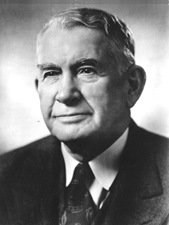Emory University
| Emory University | |
|---|---|
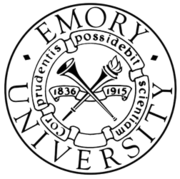 The seal of Emory University |
|
| Motto | Cor prudentis possidebit scientiam |
| Motto in English | The wise heart will possess knowledge |
| Established | 1836 |
| Type | Private |
| Religious affiliation | United Methodist Church[1][2] |
| Endowment | US $4.5 billion, as of August 31, 2009[update][3] |
| President | James W. Wagner |
| Students | 12,756 |
| Undergraduates | 6,890 |
| Postgraduates | 5,865 |
| Location | Druid Hills, Georgia, US |
| Campus | Suburban 631 acres (2.6 km²) |
| Colors | Blue and Gold |
| Athletics | NCAA Division III UAA |
| Nickname | Emory Eagles |
| Affiliations | Southern Association of Colleges and Schools, AAU |
| Website | Emory.edu |
 |
|
Emory University is a private research university located in the metropolitan Atlanta area of Druid Hills, Georgia. The Oxford College campus is located in Oxford, Georgia, where the university was founded in 1836 by a small group of Methodists as Emory College, which was named in honor of John Emory, a well-known Methodist bishop. The university follows a mission statement “to create, preserve, teach, and apply knowledge in the service of humanity" [4]. The school struggled financially until a generous land-grant by Asa Candler, the president of the Coca-Cola Company, allowed the small college to move to DeKalb County near Atlanta and become rechartered as Emory University.
Today, the school consists of nine academic divisions: The College of Arts and Sciences, Oxford College, Laney Graduate School, School of Law, School of Medicine, Nell Hodgson Woodruff School of Nursing, Rollins School of Public Health, Candler School of Theology, and Roberto C. Goizueta Business School.
Emory’s undergraduate program was ranked 17th in the nation in the 2010 edition of the U.S. News & World Report [5]; its medical and law programs are also among the top 25 in the country [6] [7]. Newsweek named it one of its 25 “New Ivies”[8]. Its close to 3,000 faculty members have received a variety of honors, including American Academy of Arts & Science Fellow, American College of Cardiology Master, Carnegie Scholar, Fulbright Fellowship, Guggenheim Fellowship, National Book Award, National Academy of Sciences, National Humanities Medal, National Endowment for the Humanities Fellowship, and Pulitzer Prize.
In recent years, Emory has become dedicated to issues relating to sustainability and the environment. The University has more than two million square feet of building space that has been certified by the Leadership in Energy and Environmental Design (LEED) program and has a commitment to having three-quarters of the food they serve on campus come from local or sustainable sources by 2015[9]. The University holds the distinction of having one of the largest inventories by square footage of LEED-certified building space among campuses in America.[10]
Emory’s students and faculty members are dedicated to giving back the community. The University received the 2008 Presidential Award for General Community Service, which is the highest federal recognition given to higher-education institutions for their commitment to community service, service-learning and civic engagement [11].
History

In 1836, a small group of Methodists from Newton County contemplated the establishment of a new town and college. The town was named Oxford after the school's prestigious British namesake,[12] which graduated the two founders of Methodism, John and Charles Wesley.[13] The college was named after John Emory, an American Methodist bishop who inspired them.[12]
Events preceding the chartering of Emory College began in 1783, when the Georgia State legislature provided for the founding of "a college or seminary of learning." However, general support of education in Georgia was meager until the 1830s, when an educational fad in Germany inspired Georgia Methodists to create a school for manual labor.[13] At the Georgia Methodist Conference in 1834, a preacher known as "Uncle Allen" Turner suggested that Georgia Methodists should develop their own school rather than support Randolph-Macon in Virginia.[14] As a result, the Manual Labor School was created in Covington, Georgia in 1835.
On December 10, 1836, the Georgia General Assembly granted the Georgia Methodist Conference a charter to Emory College, named for John Emory, a popular bishop who had presided at the 1834 conference but had died in a carriage accident in 1835.[13] Two years after the chartering, the college opened its doors, and on September 17, 1838, the college's first president, Ignatius Alphonso Few, and three faculty members welcomed fifteen freshmen and sophomores.[14]

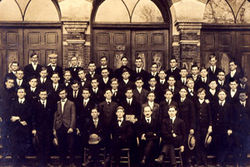
Emory College imposed a strict environment during most of the nineteenth century. By signing their names into the Matriculation Book, students were bound to obey the "Laws and Statutes of the College," which bound students to their rooms during study hours, and forbade them from leaving the town limits without the president's consent and engaging in immoral activities.[13] Until the presidency of Warren Candler in the 1890s, Emory prohibited intercollegiate sports. He thought the practice "evil, only evil, and that continually," his principle objection being the cost of intercollegiate athletic programs, the temptation of gambling, and the distraction from academics.[13] However, he was not unalterably opposed to athletics, and during his presidency he raised funds for the first gymnasium at Emory and oversaw the creation of the nation's first model intramural program.
Emory College was closed briefly during the Civil War. In the autumn of 1861, every student left to fight, and the college's trustees closed for the duration. During the war, the college's buildings saw duty both as a Confederate hospital and Union headquarters.[13] When Emory reopened in January 1866, the school's library was destroyed and its small endowment was depleted.[14] Only with the aid of a state grant could students afford to resume their education.
In the years following the Civil War, Emory, along with the rest of the South, struggled to overcome financial devastation.[12] The first step toward financial stability came in 1880, when Emory President Atticus G. Haygood preached a Thanksgiving Day sermon expressing gratitude for the end of slavery captured the attention of George Seney, a Brooklyn banker and Methodist. Seney gave Emory College $5,000 to repay its debts, $50,000 for construction, and $75,000 to establish a new endowment.[14] Over the years, Seney invested more than a quarter-million dollars into Emory College, helping to erect the administration building in Oxford that bears his name.
Under the direction of President Haygood's direction, Emory College began to offer many technical and professional subjects in addition to courses required for degrees.[15] By the turn of the century, Emory had evolved its traditional liberal arts program into a broad curriculum encouraging students to pursue degrees in science, study in theology and law, and even learning and expertise in technology and tool craft. The technology department was launched by President Isaac Stiles Hopkins, a polymath professor at Emory College, who was later convinced by state legislators to become the first president of what is now the Georgia Institute of Technology.[13]
The course of Emory's history changed dramatically when, in November 1979, Robert and George Woodruff presented the institution with a gift of $105 million in Coca-Cola stock. At the time this was the largest single gift to any institution of higher education in American history, and it made a profound impact on Emory's direction in the next two decades, boosting the university to the top ranks of American research universities.[13]
Organization
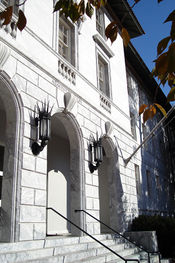
The College of Arts and Sciences is the undergraduate institution of Emory University with 66 majors, 53 minors, 17 joint concentrations, and 10 interdepartmental programs leading to a bachelor's degree. It enrolls approximately 6,000 undergraduate students. The Oxford College of Emory University, located in Oxford, Georgia, enrolls about 700 students. Students at Oxford traditionally complete their first two years of their degree at Oxford and then continue at the College of Arts and Sciences (located on the Atlanta campus) to complete their bachelor's degrees. Because of its size, Oxford College provides low student-teacher ratios in classrooms and a close-knit social community typical of liberal arts colleges.
The Graduate School has degree programs in 26 divisions in which students receive either master's or doctoral degrees. The Candler School of Theology is allied with the United Methodist Church, but enrolls students from 45 different denominations. The Goizueta Business School was ranked 20th nationally by U.S. News and 18th by Forbes for their MBA program; the undergraduate program was ranked 4th by BusinessWeek in 2007. Emory Law School is currently ranked 20th by U.S. News and World Report.
The Emory Healthcare System is the largest healthcare provider in Georgia and educates doctors, nurses, and other health professionals. The Emory University School of Medicine enrolls approximately 425 medical students, 1,000 residents and fellows, and 350 allied health students. Collaborating with the nearby Centers for Disease Control and Prevention and other public health organizations, the Rollins School of Public Health has about 800 graduate students. The Nell Hodgson Woodruff School of Nursing enrolls approximately 175 undergraduate students and 175 graduate students.
The Financial Aid Office awards need-based financial aid to all qualifying students through institutional and federal grant and loan packages. In January 2007, the University announced its newest aid program, Emory Advantage. Emory Advantage seeks to help undergraduate dependent students from families with assessed annual incomes $100,000 or less who demonstrate a need for financial aid. The program reduces the amount of money borrowed to pay for an undergraduate Emory degree. The goal is to make an Emory education attainable for any qualified student, regardless of income.
The Loan Replacement Grant (LRG) replaces loans for dependent undergraduate students whose families' assessed annual incomes are $50,000 or less. Grants replace need-based loans to cover expenses including tuition, room, and board. The eligible grant amount represents the student's self-help portion normally given in the form of a loan.
The Loan Cap Program (LCP) caps cumulative need-based debt at $15,000 for dependent undergraduate students whose families' assessed annual incomes are between $50,001 and $100,000. With the Loan Cap Program, students receive a standard financial aid award for freshman and sophomore years. This estimated award could include federal or state aid, institutional loans or grants, or Work-Study. After a student has accrued a total of $15,000 in need-based loans, Emory will provide grants to cover any remaining need-based funding incurred through degree completion.
Academics
Profile
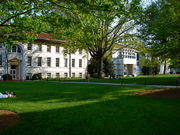
Emory College of Arts & Sciences (1919)
The College has 48 departments and programs. It offers its 5,500 students the choice of 70 majors, 17 joint concentrations, and 56 minors [16]. Fifty-two percent of students earn a double major or both a major and a minor [17]. Students must also complete general education requirements (GERs) that are designed to expose all students to a variety of topics, including physical and social sciences, the humanities, and foreign languages. About 47% of students pursue independent research or work on research projects with faculty members in the sciences, humanities, and social sciences during their time in the College. About half of all students study abroad for a semester, summer, or year and 63% complete internships [18] [19].
Emory has matriculated 18 Rhodes Scholars and 13 Marshall Scholars, and houses a chapter of Phi Beta Kappa, the oldest and most prestigious national academic honor society. For the College’s graduating class of 2010, the average cumulative GPA was 3.38, and 45.5 % of the class earned a cumulative GPA of 3.5 or higher [20].
After graduation, 41% of undergraduates plan to continue to graduate or professional school. Two-thirds of all Emory College classes have fewer than 20 students; 7% have more than 50 [21].
Dual-degree program with the Georgia Institute of Technology
After the installation as James W. Wagner as Emory’s president in 2003, a dual-degree program in engineering was introduced in collaboration with the Georgia Institute of Technology. The five-year program allows Emory students to enroll in engineering classes at Georgia Tech throughout the course of their term at Emory. After the completion of the required course load, students typically graduate with a degree from Emory College or the Goizueta Business School and an engineering degree from Georgia Tech in one of twelve fields [22]. The program has been instrumental in strengthening Emory's reputation as a college with a wide spectrum of opportunities.
Oxford College (1836)
When students apply to Emory for their first year, they may apply the College of Arts and Sciences or to Oxford College, which is located about 40 miles from Emory’s main campus and is the site of Emory’s founding. Oxford offers students that are interested in Emory the opportunity to experience a smaller community, as there are about 750 students enrolled in Oxford College. Typically, students graduate from Oxford after four semesters and continue to the Druid Hills campus, where they can enroll in any one of Emory’s undergraduate programs. GERs and courses for any of the academic majors offered in the Emory College of Arts and Sciences may be taken at Oxford College [23].
School of Medicine (1854)
There are six degree programs within the Emory University School of Medicine: M.D., M.D./PhD, Physician Assistant (MMSc), Medical Imaging (BMSc), Anesthesiology and Patient Care (MMSc), and Physical Therapy (DPT). To complete the M.D./PhD program, students enroll in both the School of Medicine and either the Laney Graduate School or Georgia Tech. Additionally, there is a dual-degree M.D./MPH in partnership with the Rollins School of Public Health.
Nell Hodgson Woodruff School of Nursing (1905)
Undergraduates in the School of Nursing may complete a B.S. in nursing by taking one of four different paths. One of these is an Accelerated Bachelor of Science in Nursing and Master of Science of Nursing program. Graduate students may pursue one of three Masters degrees (MSN, RN-MSN, MSN-MPH) or a PhD [24].
Candler School of Theology (1914)
The Candler School of Theology offers four degrees: Master of Divinity, Master of Theological Studies, Master of Theology, and Doctor of Theology in Pastoral Counseling. Students may also pursue one of six joint degrees through dual enrollment in Goizueta Business School, the School of Law, or Rollins School of Public Health [25].
School of Law (1916)
Students in the Emory University School of Law may earn a Doctor of Law degree (JD), a Doctor of Judicia Science (SJD) or one of four dual degrees with the Goizueta Business School, Candler School of Theology, or Rollins School of Public Health [26].
Roberto C. Goizueta Business School (1919)
Students of the College of Arts and Sciences or Oxford College may apply for admission in to Goizueta Business School. Once accepted to the Business School, they may still continue to take courses or pursue a major in another undergraduate division. The business school has an undergraduate Bachelor of Business Administration program as well as a one- or two-year Master of Business Administration program [27] [28]. Students may also pursue PhDs in accounting, finance, information systems, marketing, and information and management [29].
Laney Graduate School (1919)
Programs to receive graduate certificates, Masters degrees, and PhDs are all available through the Laney Graduate School. In seven disciplines, Masters degrees may be earned separately, but in most cases, completing a Masters is a step toward completing a PhD. There are 42 departments through which students can earn a PhD [30].
Rollins School of Public Health (1990)
Students in the Rollins School of Public Health may earn a Master of Public Health or a Master of Science in Public Health. Rollins also offers seven dual degrees through partnership with other schools in the university, a five-year collaborative program with the department of biostatistics, and four doctoral programs [31].
Rankings
| ARWU World[32] | 100 |
|---|---|
| ARWU National[33] | 62 |
| Forbes[34] | 53 |
| Times Higher Education[35] | 90 |
| USNWR National University[36] | 17 |
| WM National University[37] | 113 |
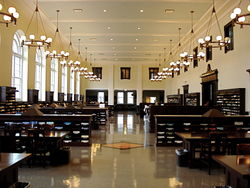
Undergraduate
In its 2010 rankings of the best colleges and universities in the United States, U.S. News and World Report placed Emory at #17, tied with Rice and Vanderbilt Universities [38]. The school is included on The Princeton Review’s list of the 371 best colleges in the United States and was named one of the publication’s best schools in the Southeast [39].
The BBA program at Goizueta Business School is ranked #7 by Bloomberg Businessweek [40].
Graduate
Many of the graduate schools of Emory University were ranked as some of the best and most competitive in their fields by U.S. News and World Report in 2010. Rollins School of Public Health was ranked at #7; the Nell Hodgson Woodruff School of Nursing was ranked at #26; the MBA program at Goizueta Business School is ranked #27; the School of Law is ranked #22; the School of Medicine is ranked #20 for research and #25 for primary care [41]. Businessweek ranked Goizueta’s full-time MBA program at #23 in 2010 [42].
Enrollment Facts
Undergraduate
Emory's is home to 6,980 undergraduates. Its student body is the most ethnically and religiously diverse of any of the top-20 national research universities, with 12,755 students (undergraduate, graduate, and professional schools) from 50 states and 106 countries [43]. For the undergraduate class of 2013, Emory received 15,610 applications [44]. Academically, the incoming freshman class earned an average GPA of 3.82 in high school. Its median SAT scores range from 1320 to 1460 for the combined critical reading and math sections [45].
Oxford College
After two years at Oxford College, students graduate and may attend any of the undergraduate divisions of Emory’s Druid Hills campus. There are 753 students at Oxford College [46]. For the Oxford class of 2012 (which will go on to graduate Emory in 2014), 58% of the 3,873 applicants were accepted. The incoming freshman class earned an average GPA of 3.5 in high school and median SAT scores of 1160 to 1340 [47].
Goizueta Business School Bachelor of Business Administration Program
There were 317 admitted to Goizueta Business School’s class of 2011. Its average SAT score was 1371 and its average college GPA is a 3.58 [48].
Nell Hodgson Woodruff School of Nursing
The School of Nursing currently has 378 students—218 undergraduates, 160 graduate students, and 10 in the doctoral program. For class starting in the fall of 2010, 256 of the 593 applicants were admitted to the undergraduate program and 144 of the 198 applicants were admitted to the masters program [49]. The average GPA for admitted students in the bachelors program is 3.45 and 3.3 for the masters program [50].
Graduate
As of 2010, Emory has 5,950 graduate and professional students [51].
Laney Graduate School
As of 2009, there were 1,910 graduate students at Emory, 89.6% of which were pursuing a PhD. In 2009, 12.8% of the 3,589 applicants to a Graduate School PhD program were accepted. They had an average college GPA of 3.63 [52].
School of Medicine
The School of Medicine received approximately 6,000 applications each year and accepts an average of 132 students [53]. For currently enrolled students, the average GPA is 3.7 and the average MCAT score is 34 [54].
School of Law
In the 2009-2010 school year, there were 752 students enrolled in the School of Law. For the Class of 2012, 247 students were accepted, out of 4,558 applicants. The median GPA of accepted students was 3.57 and the median LSAT score was a 166 [55].
Candler School of Theology
The School of Theology class of 2010 was composed of 171 students [56].
Goizueta Business School Master of Business Administration Program
The two-year full-time MBA program’s class of 2011 is made up of 173 students with an average GMAT score of 676 and an average undergraduate GPA of 3.3 [57]. In the one-year full-time MBA program, there are 41 students in the class of 2011. Its members have a middle 80% GMAT score of 560-730 and an average undergraduate GPA of 3.4 [58].
Rollins School of Public Health
The incoming class of the Rollins School of Public Health has 441 students with an average undergraduate GPA of 3.4 and an average graduate GPA of 3.5 [59].
Student life
Residential Life
Emory requires its students to live on campus for the first two years of undergraduate life. This requirement is justified by the administration as an effort to help "foster a sense of community and involvement in college life."[60] Thus more than 70% of undergraduates live on Emory's main campus. All freshmen are housed in one of nine residences on the Druid Hills campus. Sophomores may elect to live on the Druid Hills campus or in the Clairmont Tower, which is located on the Clairmont Campus. Juniors and Seniors may elect to live off-campus or on the Clairmont campus.
A new Freshman Quad is under construction. Currently, the new freshman residential complex contains three residence halls—Turman, Few, and Evans Halls—all LEED-certified. Freshman Hall Four is under construction and is slated to open in Fall 2010. The freshman quad will include as many as 8 buildings to centralize freshman living arrangement.
Fraternities have existed on Emory's campus as early as 1840. One early chronicler makes the case that Emory's "temple" of the Mystic Seven may have been the first chapter of a national fraternity established anywhere in the South. Today, the Greek-letter sororities and fraternities play an important part in leavening Emory's campus life. For undergraduates, Greek life comprises approximately 30% of the Emory student population. The Office of Greek Life recognizes 12 fraternities and 13 sororities. Eleven fraternities have on-campus housing located on Eagle Row. Ten sororities live in Sorority Village, a series of townhouses facing the fraternity houses on Eagle Row. Greek Life is an important social engagement for students, but it is not totally exclusive like at other schools. Students from different sororities and fraternities regularly socialize. The college's emphasis on on-campus housing helps students make many friends inside and outside the Greek system. Emory also has four secret societies—the D.V.S. Senior Honor Society, the oldest society, founded in 1902; Ducemus; the Order of Ammon; and the Paladin Society.

Traditions at Emory include Dooley, the "Spirit of Emory" and the unofficial mascot of the university. Dooley is a skeleton and is usually dressed in black. The name "Dooley" was given to the unofficial mascot in 1909.[61] Each year in the spring, during Dooley's Week, Dooley roams Emory's campus flanked by bodyguards dressed in all black ("Dooley guards") and lets students out of class with unscheduled appearances in classrooms. He typically walks slowly with an exaggerated limp. A spokesperson amongst the bodyguards walks with him to deliver his messages as he never speaks himself. His identity is unknown and this and how his guards are involved with the tradition is often fodder for campus gossip. He adopts the first name and middle initial of the University's current president. As such, Dooley's current full name is James W. Dooley, after James W. Wagner. Dooley's Week culminates with Dooley's Ball, a grand celebration that takes place in the center of campus on McDonough Field held in celebration of Dooley and Emory University. A sporting match called the Dooley Cup is played between the university administration and the student government association each spring as well, and the SGA remains undefeated. Dooley has also been known to address more serious matters, particularly at the Oxford Campus.
Clubs and activities
Student organizations
Approximately 320 student clubs and organizations operate on Emory's campus. These include numerous student government, special interest, and service organizations. The most prominent amongst these are the Emory Student Government Association (SGA) and the Student Programming Council (SPC). The Student Government Association (SGA) charters and provides most of the funding for other student groups, and represents students' interests when dealing with the administration.[62] The Student Programming Council (SPC) is the school's primary programming organization, and they are responsible for planning five big events every year: Homecoming Week, Fall Band Party, Spring Band Party, Swoopstock and Dooley's Week.[63] According to the 2006 National Survey of Student Engagement, Emory students spend an average of six to ten hours a week participating in co-curricular activities on campus (more than double that of their peers), including a variety of intramural sports, cultural clubs, volunteer organizations.[64]
One of the most popular activities on campus is competing in sports. Emory has over 20 sports clubs and a variety of recreational and competitive intramural teams that are officially recognized.[65][66] Performance groups such as No Strings Attached, Emory's oldest a capella group, is also prominent, and can be seen in venues throughout the region.
Community service
About 25% of Emory students participate in Volunteer Emory, Emory's umbrella community service group. As one of the most popular groups on campus, Volunteer Emory offers dozens of ways to serve the community, working with varied organizations including the Atlanta Community Food Bank, Trees Atlanta, PAWS Atlanta, and Jones Boys and Girls Club. Students provided nearly 150,000 hours of service in 2008, working with more than 200 community partners. For their vast contributions, Emory received the 2008 Presidential Award for General Community Service, the highest federal recognition made to a college or university for its commitment to volunteering, service-learning, and civil engagement.
Emory also established 'Emory Cares Day', during which students of the University volunteer at a number of projects organized by Emory and it's many partners around the city of Atlanta and greater parts of Georgia. This day of service is considered to be a way of giving back to the community, a tradition Emory and it's benefactors have kept up since the school's establishment.
Student Media
The Emory Wheel, Emory's undergraduate student newspaper, has been continually published since 1919 and has a circulation of about 5,500 throughout the campus and surrounding area. It is financially independent from the University, covering its costs from self-generated advertising sales. More than 100 students staff The Wheel and its sister magazine, The Hub, founded in 2005 and published quarterly.[67][68] WMRE, Emory's student operated radio station, began broadcasting in 1989. Although it was initially only available to on-campus listeners, it now enjoys a worldwide audience.[69]
Other University publications include The Spoke, The Lullwater Review, Emory Political Review, and Black Star Magazine.
Athletics

Intramural and club
Intercollegiate sports were prohibited at Emory from its initial founding until the presidency of Warren Candler. Candler thought the practice "evil, only evil, and that continually." His principal objections were the cost of intercollegiate athletics programs, the temptation to gambling, and the distraction from scholarship. Candler was not unalterably opposed to athletics, however. During his presidency, he oversaw the creation of the nation's first model intramural program. This "athletics for all" strategy, which emphasized the physical and social aspects of student development and learning in conjunction with academic pursuits, rose to national prominence during the 1920s, prompting many other institutions to emulate it. [13]
Today, the intramural sports program provides an athletic outlet for the entire Emory community. Undergraduates, graduate students, and faculty and staff members compete in both competitive and recreational leagues including flag football, soccer, softball, and basketball.
Club sports provide additional competitive opportunities that many students take advantage of. Unlike students that participate in intramural sports, those who participate in club sports compete against other colleges and universities. The club sports program incorporates instruction and competition. Club teams include crew, rugby, ultimate, ice hockey, lacrosse, volleyball, sailing, fencing, weightlifting, and equestrian, among others [70]. Many students also participate in the Outdoor Emory Organization—an organization that sponsors weekend trips of outdoor activities such as rafting, rock climbing and hiking [71].
Intercollegiate
Emory's 18 varsity sports teams, known as the Eagles, are members of the NCAA’s Division III University Athletic Association (UAA) [72]. Emory's intercollegiate programs regularly rank among the top ten NCAA Division III. The swimming and diving team, according to the NCAA rankings, is considered to be one of the top programs in the nation. The women’s team came in first place in 2005, 2006, and 2010 and finished in the top four in 2007, 2008, and 2009. In 2006, the men’s and women’s tennis teams were Division III National Champions. The volleyball team won its National Championship in 2008 [73].
A popular myth, even among Emory students, is that the university still does not have a football team because Robert Woodruff would only give money to the school on the condition that it never had one because his own son had died during a vicious football game. In reality, Woodruff never had any children [13].
Sports and Scholarship
The academic and athletic communities at Emory are not insular. Emory is one of a few schools in the United States to rank in the top 20 in both the U.S. News & World Report’s rankings of the best national universities and the Directors Cup of the National Association of Collegiate Directors of Athletics for best all-around athletics program [74]. In 2010, varsity athletes at Emory were recognized with the UAA’s top academic honor, academic accolades from ESPN The Magazine, and the NCAA Postgraduate Scholarship [75] [76] [77]. Emory athletes have been awarded 67 postgraduate scholarships in the school's history. Fifty of these have been since 2000, which is more than any other NCAA institution, with the exception of Stanford University, which has 53 [78].
Arts
Students may engage in the performing and fine arts as an area of academic study or as extracurricular activities. Undergraduates may pursue a major in the performing arts (dance, theater, or music) or in film studies, art history, visual arts, or creative writing[79]. Graduate programs in art history, film studies, and music are offered[80].
There are more than 50 student organizations dedicated to the arts. Students can explore artistic interests as diverse as architecture, breakdancing, poetry, and improvisational comedy[81].
Emory routinely hosts arts events in the Schwartz Center for Performing Arts that are open to the Emory and Atlanta communities. Recent performances include Bang on a Can All-Stars (a side project of drummer Glenn Kotche from the rock band Wilco), jazz performer Esperanza Spalding, and New York’s Cedar Lake Dance Company. A program called Creativity Conversations brings artistic minds to campus to discuss art and the creative process. Guests have included Philip Glass, Jimmy Carter, Salman Rushdie, and Seamus Heaney[82].
Campus Facilities
Michael C. Carlos Museum
The Carlos Museum houses one of the most comprehensive art collections in the Southeast, with works from ancient Egypt, Near East, Greece, Rome, ancient Americas, Africa, and Asia. The museum has been adding to its collection since 1876, when a small museum was opened on the Oxford campus [83]. Its permanent collection includes such pieces as an influential statue of Aphrodite from the first century B.C., which was in two parts until it was fixed by a Carlos employee [84]. One of the most notable exhibitions that the Carlos Museum has had was an exhibition about Egyptian pharaoh Tutankhamun (“King Tut”), which was on display for the first time in 26 years [85].
Students may visit the Carlos Museum for free. Many of the curators teach courses at the University and faculty in other departments, including dance and physics, often use the museum as part of their curriculum.
Manuscripts, Archives, and Rare Books Library (MARBL)
Emory’s Robert W. Woodruff University Library has been ranked #13 in the nation, according to The Princeton Review [86]. The library’s tenth floor is home to MARBL, which has rare materials relating to literature, African American history and culture, and Southern and Georgia history. Notable pieces of the MARBL collection include a rare first edition of Robinson Crusoe by Daniel Defoe[87], as well as works by Flannery O’Connor, Alice Walker, Langston Hughes, W.B. Yeats, and Seamus Heaney. All students have complete access to MARBL and members of the public may also use the library.
Many of these authors become subjects of exhibitions in Schatten Gallery, which is located on the third floor of Woodruff Library and houses various displays throughout the year.
Lullwater Park
Lullwater Park is a space of more than 100 acres of undeveloped recreational space. The park has walking trails, open spaces to play sports, and a lake. The home of the University President and his family is located in the park. The only vehicles allowed in the park are those that have received special permission because they are visiting the president’s house [88].
Yerkes National Primate Research Center
The Yerkes National Primate Research Center is one of only eight National Institutes of Health–funded national primate research centers. Between its two locations—the main center on Emory’s Druid Hills campus and a secondary location in Lawrenceville, Ga.—the Center has nearly 3,400 nonhuman primates and 13,000 rodents.
Since 1930, the Center has been conducting research in the fields of microbiology and immunology, neurologic diseases, neuropharmacology, behavioral, cognitive and developmental neuroscience, and psychiatric disorders. Current research includes developing vaccines for infectious and noninfectious diseases, treating drug addiction, and increase understanding of illnesses such as Alzheimer’s and Parkinson's diseases[89][90].
Centers for Disease Control and Prevetion (CDC)
The CDC has shared a close relationship with Emory since it purchased the land for its facilities from the University for $10 in 1947. Many programs, especially through the Rollins School of Public Health and School of Medicine, allow students to take advantage of the proximity of and research done at the CDC. Graduate students studying Population Biology, Ecology & Evolution may attend CDC training stations in Kenya, India, Montana, or New Mexico [91]. Similarly, Emory medical students may apply to study under epidemiologists from the CDC[92].
The Carter Center
Emory is partnered with the Carter Center, a not-for-profit organization founded by former U.S. President Jimmy Carter to further human rights. Carter usually visits Emory’s campus several times throughout the year. Most notably, he hosts Carter Town Hall, an open-forum event for all first-year students.
The Donna and Marvin Schwartz Center for the Performing Arts
The Donna and Marvin Schwartz Center for Performing Arts, which reopened in the fall of 2001, hosts professional and student-run performances throughout the year [93]. The theater was originally built in 1904, when it was known as The Dover Opera House. The theater went through many changes until 1982, when it closed down. A fund-raising campaign raised enough money to renovate the theater [94]. In addition to various practice facilities and smaller performance spaces, The Schwartz Center now includes Cherry Logan Emerson Concert Hall, which has 825 seats and a large pipe organ.
Sustainability
LEED-Certified buildings and green space
Buildings on Emory’s campus must comply with the guidelines set by U.S. Green Building Council’s Leadership in Energy and Environmental Design (LEED). In order to receive LEED certification, a building must meet standards relating to indoor air quality, energy and water conservation, and be at least partially constructed with recycled, renewable or locally-sourced materials.
Emory’s Whitehead Biomedical Research Building, which was constructed in 2000, was the first LEED-certified building to be built in the Southeastern United States. Currently, the University has one of largest inventories of LEED-certified building space in academia in America, and all new construction must at least meet the silver LEED Certification.
The University also has a policy to preserve green space on campus. For every tree that is removed for new construction, another must be planted. Additionally, the Campus Master Plan dictates that 48% of the school’s 700 acres must remain undeveloped[95].
Food service
The University has a goal to have 75% of the food served in its cafeterias and hospitals be sustainable or locally grown by 2015.
Emory’s campus currently has eight small educational gardens, where fresh fruits and vegetables are grown. These gardens are meant to increase awareness about local produce and remind members of the community that they can reduce fossil fuel use by eating locally. The upkeep of the gardens is the responsibility of members of the Emory community. Every Tuesday during the school year, there is a farmers market on campus, where local farmers and vendors can sell their sustainable products[96].
Transportation
Emory has a pedestrian campus, and only service and safety vehicles are allowed to drive through most academic spaces.
The Cliff shuttle system, named for Clifton Road which borders campus, provides transportation for students, faculty, and staff who must travel greater distances. Satellite parking is provided for employees throughout the city to reduce congestion around Emory. These shuttles are powered by alternate fuel, much of which is made from recycled cooking oil from the University’s kitchens and hospital[97].
Students can rent bicycles for free with their Emory ID cards. Emory also has a partnership with Zipcar, a company that rents cars for short-term usage and supports environmentalism. By renting a Zipcar rather than having their own, students can reduce their carbon footprint by also reducing the number of cars on the road and the amount of gas and oil they use[98].
Minor in Sustainability
Emory students have the option of completing a minor in sustainability. The minor requires courses on the social, environmental, and economic elements of sustainability, as well as a hands-on component, such as research or an internship[99].
Emory in Popular Culture
Film
- Some scenes of the 2011 film Hall Pass, a comedy that stars Owen Wilson as a man whose wife allows him to have an affair and was directed by the Farrelly brothers, were shot outside the Alpha Tau Omega and Kappa Alpha Order fraternity houses on Emory’s Eagle Row. [100][101]
- The 2007 documentary about former president Jimmy Carter, Jimmy Carter: Man From Plains, features a scene of Carter being interviewed by the editor in chief of Emory’s student newspaper, The Emory Wheel. [102]
- The novel Into the Wild by Jon Krakauer and subsequent film by the same title are about 1990 Emory College of Arts and Sciences graduate Christopher McCandless, who gave away his possessions and hitchhiked to Alaska to live in the wilderness after graduation. Production of the 2007 film brought its director and writer, Sean Penn, to Emory’s campus, and some footage for the movie were filmed during the 2006 Commencement ceremonies. [103]
- For the 2005 film version of The Dukes of Hazzard, the crew visited Oxford College to pay homage to the television series on which it was based. The first episode of the series featured a car jump with Oxford College’s Seney Hall in the background. The jump was also featured in the opening credits of the series. [104]
- The 2005 independent film Kathy T (also known as Kathy T Gives Good Hoover), about a college student whose life becomes more exciting after he reads some graffiti about Kathy T and decides to track her down, was written and directed by Emory University professor of film studies Ken Lieberman. Lieberman shot many scenes in a residence hall and fraternity house on campus and primarily used Emory students for extras. [105]
- All of the colleges and universities featured in the 2000 comedy Road Trip, which is about a college student and some of his friends who drive to Texas to prevent his girlfriend from watching an explicit video of him with another girl, are fictional. Many scenes that took place on these campuses, particularly the University of Ithaca, were shot on Emory’s campus. [106]
Television
- Scenes for The CW television show The Vampire Diaries were shot in Oxford College’s Hoke O’Kelley Library. [107]
- Scenes from The Simple Life of Noah Dearborn, a 1999 made-for-TV movie about a 91-year-old carpenter that must protect his land from being turned into a strip mall were shot on Emory University’s Druid Hills campus. [108]
Notable Alumni/Faculty
 Newt Gingrich, former Speaker of the House of Representatives |
 Lucius Quintus Cincinnatus Lamar II, former U.S. Supreme Court Justice |
 Arnall Patz, Ophthalmology researcher and Presidential Medal of Freedom recipient |
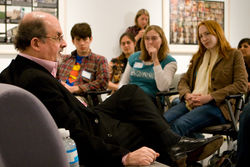
Notable faculty members at Emory have included:
- Jimmy Carter, former President of the United States, Nobel Laureate (2002) and University Distinguished Professor since 1982[109]
- The Dalai Lama (Tenzin Gyatso), Nobel Laureate (1989) and Emory Presidential Distinguished Professor in 2007
- Elizabeth Fox-Genovese (died January 2007), a feminist American historian and a primary voice of the conservative women's movement
- Dennis Liotta, Professor of Organic Chemistry and coinventor of the best selling AIDS drug emtricitabine along with Raymond Schinazi
- Deborah Lipstadt, Professor of Modern Jewish and Holocaust Studies and author of Denying the Holocaust: The Growing Assault on Truth and Memory (1994)
- Thomas R. Flynn, Samuel Candler Dobbs Professor of Philosophy, internationally renowned expert on 20th Century French Philosophy and the author of 'Sartre and Marxist Existentialism: The Test Case of Collective Responsibility,' the two volume 'Sartre, Foucault and Historical Reason: Toward and Existentialist Theory of History,' and 'A Post-Structuralist Mapping of History'
- Jean-François Lyotard, late Robert Woodruff Professor and prominent French postmodernist philosopher
- Catherine Manegold (retired to write her second book in 2005), Pulitzer Prize-winning reporter as part of a team at The New York Times
- Charles W. Nuckolls (1990–1999), winner of the Stirling Award for Contributions to Psychological Anthropology and author of Culture: A Problem that Cannot be Solved
- Christopher McCandless (died august 1992), A Legendary Itinerant.
- Sir Salman Rushdie, author and literary scholar
- Kevin Young (poet), a well-published poet
- Wole Soyinka, Nobel Laureate (1986) and author, former Distinguished Visiting Professor
- Sam Cherribi, former member of the Dutch House of Representatives (1994–2004). Now a senior lecturer in the department of sociology
- Natasha Trethewey, Pulitzer Prize-winning poet and Professor of English
- Desmond Tutu, Nobel Laureate (1984) and Anglican archbishop, past visiting professor of theology
- Frans de Waal, Charles Howard Candler Professor of Primate Behavior, foreign associate of the United States National Academy of Sciences
- Isabel Wilkerson, Pulitzer Prize-winner reporter and former New York Times correspondent
- Johnetta B. Cole, renowned African-American educator, former president of Spelman College and Bennett College
- Marion Creekmore, former U.S. Ambassador to Sri Lanka
- Sanjay Gupta, an American physician and a contributing CNN chief health correspondent based in Atlanta, Georgia
- Jonathan Simons, President and Chief Executive Officer of the Prostate Cancer Foundation
- Narasimhan Jegadeesh - Dean's Distinguished University Chair in Finance at the Goizueta Business School and creator of the Momentum (finance) theory
- Mark Bauerlein, author of The Dumbest Generation: How the Digital Age Stupefies Young Americans and Jeopardizes Our Future
- Courtney Brown, social scientist and proponent of remote viewing, Founder of the Farsight Institute, Author of several books on non-linear mathematics and remote viewing.
- Robert Agnew, Samuel Candler Dobbs Professor of Sociology and developer of General Strain Theory
References
- ↑ Separated brethren: a review of Protestant, Anglican, Eastern Orthodox & other religions in the United States. Our Sunday Visitor. http://books.google.com/books?id=sw9ILcqw2hsC&pg=PA162&lpg=PA162&dq=salvation+of+separated+brethren&source=bl&ots=ydrVxGCZ6w&sig=L_-DZRvpoMtZSDkrT6HNQcmd4aU&hl=en&ei=xfSvS52yE4faNZX_zJkF&sa=X&oi=book_result&ct=result&resnum=3&ved=0CA0Q6AEwAjgK#v=onepage&q=methodist&f=false. Retrieved 2010-03-27. "Among Protestant denominations, Methodists take first place in hospitals and colleges. Some of their one hundred colleges and universities have all but severed ties with the denominations, but others remain definitely Methodist: Syracuse, Boston, Emory, Duke, Drew, Denver, and Southern Methodist. The church operates three hundred sixty schools and institutions overseas. Methodists established Goodwill Industries in 1907 to help handicapped persons help themselves by repairing and selling old furniture and clothes. The United Methodist Church runs seventy-two hospitals in the United States."
- ↑ "Schools by Jurisdiction". United Methodist Church. http://www.gbhem.org/site/c.lsKSL3POLvF/b.5392245/k.60B4/Schools_by_Jurisdiction.htm#S.Eastern. Retrieved 2009–11–26.
- ↑ "Facts & Figures". Emory University. http://www.emory.edu/home/about/factsfigures/index.html#economic. Retrieved 2010-07-10.
- ↑ "University Mission Statement". Emory University. 2010. http://www.emory.edu/president/governance/mission_statement.html. Retrieved 2010-08-02.
- ↑ "National Universities Rankings". U.S. News and World Report. 2010. http://colleges.usnews.rankingsandreviews.com/best-colleges/national-universities-rankings. Retrieved 2010-08-02.
- ↑ "Research Rankings: Best Medical Schools". U.S. News and World Report. 2010. http://grad-schools.usnews.rankingsandreviews.com/best-graduate-schools/top-medical-schools/research-rankings. Retrieved 2010-08-02.
- ↑ "Rankings - Best Law Schools". U.S. News and World Report. 2010. http://grad-schools.usnews.rankingsandreviews.com/best-graduate-schools/top-law-schools/rankings. Retrieved 2010-08-02.
- ↑ "America's New Elite "Ivies"". Newsweek. 2006-21-08. http://www.newsweek.com/2006/08/20/25-new-ivies.html. Retrieved 2010-08-02.
- ↑ "Sustainability". Emory University. http://www.emory.edu/home/community/sustainability.html. Retrieved 2010-08-02.
- ↑ [1]
- ↑ "Emory Receives Top Service Recognition". The Emory Wheel. 2009-09-02. http://emorywheel.com/detail.php?n=26552. Retrieved 2010-08-02.
- ↑ 12.0 12.1 12.2 "History & Traditions Overview". Emory University. http://emoryhistory.emory.edu/history/index.html. Retrieved 2009-05-27.
- ↑ 13.0 13.1 13.2 13.3 13.4 13.5 13.6 13.7 13.8 13.9 Hauk, Gary S. "A Brief History". Emory University. http://emoryhistory.emory.edu/history/index.html. Retrieved 2009-05-27.
- ↑ 14.0 14.1 14.2 14.3 English, Thomas H. Emory University 1915–1965: A Semicentennial History (Atlanta: Emory University, 1966).
- ↑ "A Sesquicentennial Timeline: 1833-1987". Emory University. http://emoryhistory.emory.edu/timeline/index.html. Retrieved 2009-05-28.
- ↑ "Majors & Minors". Emory University. http://www.emory.edu/admission/academics/majors.html. Retrieved 2010-07-28.
- ↑
- ↑ "About the College". Emory University. http://www.college.emory.edu/about/facts.html. Retrieved 2010-07-28.
- ↑
- ↑ "Profile of Emory University Class of 2010". Emory University. 2010-05-10. http://shared.web.emory.edu/emory/news/releases/2010/05/profile-of-emory-university-2010-graduates.html. Retrieved 2010-07-28.
- ↑ "About the College". Emory University. http://www.college.emory.edu/about/facts.html. Retrieved 2010-07-28.
- ↑ "Special Degrees". Emory University. http://www.college.emory.edu/current/courses/special_programs/special.html. Retrieved 2010-07-28.
- ↑ "Oxford College: A Distinctive Place". Emory University. http://oxford.emory.edu/a_distinctive_place/. Retrieved 2010-07-28.
- ↑ "School of Nursing: Academics". Emory University. http://www.nursing.emory.edu/academics/degree/index.html. Retrieved 2010-07-28.
- ↑ "Degree Programs". Emory University. http://www.candler.emory.edu/ADMISSIONS/degrees.cfm. Retrieved 2010-07-28.
- ↑ "Degree Programs". Emory University. http://www.law.emory.edu/academics/academic-catalog/degree-programs.html. Retrieved 2010-07-28.
- ↑ "The BBA Program". Emory University. http://www.goizueta.emory.edu/degree/undergra_prog.html. Retrieved 2010-07-28.
- ↑ "MBA Programs". Emory University. http://www.goizueta.emory.edu/degree/mba-programs/. Retrieved 2010-07-28.
- ↑ "PhD Programs". Emory University. http://www.goizueta.emory.edu/degree/phd/. Retrieved 2010-07-28.
- ↑ "Degree Programs". Emory University. http://www.gs.emory.edu/academics/index.php. Retrieved 2010-07-28.
- ↑ "Degree Programs". Emory University. http://www.sph.emory.edu/cms/academic_programs/degree_programs/index.html. Retrieved 2010-07-28.
- ↑ "Academic Ranking of World Universities". Institute of Higher Education, Shanghai Jiao Tong University. 2010. http://www.arwu.org/ARWU2010.jsp. Retrieved May 31, 2010.
- ↑ "United States Universities in Top 500". Institute of Higher Education, Shanghai Jiao Tong University. 2010. http://www.arwu.org/Country2010Main.jsp?param=United%20States. Retrieved May 31, 2010.
- ↑ "America's Best Colleges". Forbes. 2010. http://www.forbes.com/lists/2010/94/best-colleges-10_Americas-Best-Colleges_Rank.html. Retrieved August 19, 2010.
- ↑ "Top 200 - The Times Higher Education World University Rankings 2010-2011". The Times Higher Education. 2010. http://www.timeshighereducation.co.uk/world-university-rankings/2010-2011/top-200.html. Retrieved September 16, 2010.
- ↑ "National Universities Rankings". America's Best Colleges 2011. U.S. News & World Report. 2010. http://colleges.usnews.rankingsandreviews.com/college/national-search. Retrieved August 29, 2010.
- ↑ "The Washington Monthly National University Rankings". The Washington Monthly. 2010. http://www.washingtonmonthly.com/college_guide/rankings_2010/national_university_rank.php. Retrieved August 29, 2010.
- ↑ "National Universities Rankings". U.S. News and World Report. http://colleges.usnews.rankingsandreviews.com/best-colleges/national-universities-rankings. Retrieved 2010-07-28.
- ↑ "Emory University". The Princeton Review. http://www.princetonreview.com/schools/college/CollegeRankings.aspx?iid=1023323. Retrieved 2010-07-28.
- ↑ "Business Schools Rankings & Profiles". Businessweek. http://www.businessweek.com/bschools/rankings/. Retrieved 2010-07-28.
- ↑ "best Graduate Schools". U.S. News and World Report. http://grad-schools.usnews.rankingsandreviews.com/best-graduate-schools. Retrieved 2010-07-28.
- ↑ "Business Schools Rankings & Profiles". Businessweek. http://www.businessweek.com/bschools/rankings/. Retrieved 2010-07-28.
- ↑ "Emory University". Atlanta Regional Council for Higher Education. http://www.atlantahighered.org/MemberInstitutions/20publicandprivatecollegesanduniversities/EmoryUniversity/tabid/430/Default.aspx. Retrieved 2010-07-28.
- ↑ "Welcoming the class of 2013". The Emory Report. 2009-24-08. http://www.emory.edu/EMORY_REPORT/erarchive/2009/August/aug24/class_of_2013.htm. Retrieved 2010-07-28.
- ↑ "About the College". Emory University. 2010-22-01. http://www.college.emory.edu/about/facts.html. Retrieved 2010-07-28.
- ↑ "Oxford and Emory". Emory University. http://oxford.emory.edu/a_distinctive_place/. Retrieved 2010-07-28.
- ↑ "Admission News". Emory University. http://oxford.emory.edu/admission/. Retrieved 2010-07-28.
- ↑ "Facts & Figures". Emory University. http://www.goizueta.emory.edu/degree/undergra_factsFigures.html. Retrieved 2010-07-28.
- ↑ School of Nursing Year to Date Applicant Summary, Emory University, 2010
- ↑ "BSN Questions". Emory University. http://www.nursing.emory.edu/admission/faq.html#Cat2. Retrieved 2010-07-28.
- ↑ "Facts & Figures". Emory University. http://www.emory.edu/home/about/factsfigures/index.html. Retrieved 2010-07-28.
- ↑ "Laney Graduate School Facts & Figures". Emory University. http://www.gs.emory.edu/about/facts.php. Retrieved 2010-07-28.
- ↑ "Frequently Asked Questions". Emory University. http://www.med.emory.edu/admissions/generalquestions.cfm. Retrieved 2010-07-28.
- ↑ "How to Apply". Emory University. http://www.med.emory.edu/admissions/howtoapplyrequirements.cfm. Retrieved 2010-07-28.
- ↑ "About Emory Law". Emory University. http://www.law.emory.edu/about-emory-law/at-a-glance.html. Retrieved 2010-07-28.
- ↑ "Candler School of Theology". Emory University. http://www.candler.emory.edu/NEWS/051010.cfm. Retrieved 2010-07-28.
- ↑ "Two-Year Full-Time MBA Student Profile". Emory University. http://www.goizueta.emory.edu/degree/fulltimemba/two-year_student_profiles.html. Retrieved 2010-07-28.
- ↑ "One-Year MBA Student Profile". Emory University. http://www.goizueta.emory.edu/degree/fulltimemba/one-year_student_profiles.html. Retrieved 2010-07-28.
- ↑ "Admissions". Emory University. http://www.sph.emory.edu/cms/prospective_students/admissions/index.html. Retrieved 2010-07-28.
- ↑ "Housing & Dining". Emory University. http://www.emory.edu/home/life/housingdining.html. Retrieved 2009-07-30.
- ↑ "Traditions & Rituals". Emory University. http://emoryhistory.emory.edu/traditions/Dooleystory.html. Retrieved 8 March 2010.
- ↑ "Emory University SGA — Student Government Association". Students.emory.edu. http://www.students.emory.edu/SGA/sga/. Retrieved 2009-07-30.
- ↑ "Emory SPC - Official Website". Students.emory.edu. http://students.emory.edu/SPC/about.htm. Retrieved 2009-07-30.
- ↑ "Activities"
- ↑ "Club Sports :: Emory University". Rec.emory.edu. http://www.rec.emory.edu/clubsports/clubs/index.cfm. Retrieved 2009-07-30.
- ↑ "Recreational Services :: Emory University". Rec.emory.edu. http://www.rec.emory.edu/rec/intramurals/index.cfm. Retrieved 2009-07-30.
- ↑ "About". The Emory Wheel. 2009-05-08. http://www.emorywheel.com/about/. Retrieved 2009-07-30.
- ↑ "About". The Emory Wheel. 2010-03-24. http://www.freebase.com/view/en/the_emory_wheel/. Retrieved 2010-03-22.
- ↑ "About". Students.emory.edu. http://www.students.emory.edu/WMRE/About.html. Retrieved 2009-07-30.
- ↑ "Emory Club Sports". Emory University. http://www.rec.emory.edu/clubsports/clubs/index.cfm. Retrieved 2010-07-28.
- ↑ "General Information". Outdoor Emory Organization. http://www.students.emory.edu/OEO/. Retrieved 2010-07-28.
- ↑ "Sports & Scholarship". Emory University. http://www.emory.edu/home/life/athletics/scholar-athletes.html. Retrieved 2010-07-28.
- ↑ "Varsity Rankings". Emory University. http://www.emory.edu/home/life/athletics/rankings.html. Retrieved 2010-07-28.
- ↑ "Sports & Scholarship". Emory University. 2010. http://www.emory.edu/home/life/athletics/scholar-athletes.html. Retrieved 2010-07-28.
- ↑ "Nineteen Eagles Earn UAA's Top Academic Honor". Emory University. 2010-07-07. http://www.emoryathletics.com/General/General_Releases/2009-10UAAScholars%28070710%29. Retrieved 2010-07-28.
- ↑ "Ciardelli & Westby Named ESPN the Magazine Academic All-Americans". Emory University. 2010-06-10. http://www.emoryathletics.com/sports/wswimdive/2009-10/releases/AcademicAllAmerica%2806-10%29. Retrieved 2010-07-28.
- ↑ "Cohn Named to the ESPN the Magazine Academic All-District First Team". Emory University. 2010-05-06. http://www.emoryathletics.com/sports/bsb/2009-10/releases/AcademicAllDistrict%2805-06%29. Retrieved 2010-07-28.
- ↑ "Alex Greenhouse Wins NCAA Postgraduate Scholarship". Emory University. 2010-06-25. http://www.emoryathletics.com/sports/mtrack/2009-10/releases/greenhousencaapostgrad%28625%29. Retrieved 2010-07-28.
- ↑ "About Arts at Emory". Emory University. http://www.arts.emory.edu/about/index.html. Retrieved 2010-07-16.
- ↑ "Degree Programs". Laney Graduate School. http://www.gs.emory.edu/academics/index.php. Retrieved 2010-07-16.
- ↑ "Student Arts Groups". Emory University. http://www.creativity.emory.edu/student-art-groups.shtml. Retrieved 2010-07-16.
- ↑ "Creativity Conversations". Emory University. http://creativity.emory.edu/creativity-conversations-index.shtml. Retrieved 2010-07-16.
- ↑ "History & Mission". Emory University. http://www.carlos.emory.edu/history-mission. Retrieved 2010-08-03.
- ↑ "Carlos Fixes Broken Goddess". The Emory Wheel. 2009-04-27. http://emorywheel.com/detail.php?n=27064. Retrieved 2010-08-03.
- ↑ "Museum to Present King Tut Exhibition". The Emory Wheel. 2008-04-08. http://emorywheel.com/detail.php?n=25439. Retrieved 2010-08-03.
- ↑ "College Rankings". The Princeton Review. http://www.princetonreview.com/college-rankings.aspx. Retrieved 2010-08-03.
- ↑ "MARBL Receives 'Crusoe' Editions". The Emory Wheel. 2008-11-24. http://emorywheel.com/detail.php?n=26298. Retrieved 2010-08-03.
- ↑ "Lullwater Park". Emory University. http://www.emory.edu/HOUSING/CLAIRMONT/lull.html. Retrieved 2010-08-03.
- ↑ "History". Emory University. http://www.yerkes.emory.edu/history. Retrieved 2010-08-03.
- ↑ "About Yerkes". Emory University. http://www.yerkes.emory.edu/about-yerkes. Retrieved 2010-08-03.
- ↑ "CDC Field Training". Emory University. http://www.biomed.emory.edu/PROGRAM_SITES/PBEE/cdcFieldTraining.htm. Retrieved 2010-08-03.
- ↑ "Degree Programs". Emory University. http://www.biomed.emory.edu/PROGRAM_SITES/PBEE/cdcFieldTraining.htm. Retrieved 2010-08-03.
- ↑ "Schwartz Center for the Arts". Emory University. http://www.schwartzcenter.com/index.shtml. Retrieved 2010-08-03.
- ↑ "About the Schwartz center". Emory University. http://www.schwartzcenter.com/About.shtml. Retrieved 2010-08-03.
- ↑ "Emory Sustainability Initiatives: Green Building/Green Space". Emory University. 2010. http://sustainability.emory.edu/page/1007/green-buildings/green-space. Retrieved 2010-07-16.
- ↑ "Emory Sustainability Initiatives: Sustainable Food". Emory University. 2010. http://sustainability.emory.edu/page/1008/Sustainable-Food. Retrieved 2010-07-16.
- ↑ "Emory Sustainability Initiatives: Commute Options". Emory University. 2010. http://sustainability.emory.edu/page/1012/Commute-Options. Retrieved 2010-07-16.
- ↑ "Green Benefits". ZipCar. 2010. http://www.zipcar.com/universities/how/greenbenefits. Retrieved 2010-07-16.
- ↑ "University to Launch Sustainability Minor". The Emory Wheel. 2010-02-15. http://emorywheel.com/detail.php?n=28016. Retrieved 2010-07-16.
- ↑ "Movie-Making Farrelly's Invade Frat Row". The Emory Wheel. 2010-03-04. http://emorywheel.com/detail.php?n=28127. Retrieved 2010-07-01.
- ↑ "Wilson, Bynes to Film Scene on Emory's Eagle Row". The Emory Wheel. 2010-02-25. http://emorywheel.com/detail.php?n=28085. Retrieved 2010-07-01.
- ↑ "Jimmy Carter: Man From Plains: Missionary Man". Creative Loafing Atlanta. 2007-10-31. http://clatl.com/atlanta/jimmy-carter-man-from-plains-missionary-man/Content?oid=1270364. Retrieved 2010-07-01.
- ↑ "Sean Penn Brings Alum's Journey to the Screen". The Emory Wheel. 2007-09-28. http://emorywheel.com/detail.php?n=24329. Retrieved 2010-07-01.
- ↑ "Oxford College: Explore the Region". Oxford College. http://oxford.emory.edu/a_distinctive_place/explore_the_region/. Retrieved 2010-07-01.
- ↑ "Emory Plays Backdrop to Prof's Film". The Emory Wheel. 2004-12-07. http://emorywheel.com/detail.php?n=20259. Retrieved 2010-07-01.
- ↑ "Road Trip (2000) Filming Locations". IMDB.com. http://www.imdb.com/title/tt0215129/locations. Retrieved 2010-07-01.
- ↑ "'Vampires' Descend Upon Oxford Campus". The Emory Wheel. 2009-11-19. http://emorywheel.com/detail.php?n=27721. Retrieved 2010-07-01.
- ↑ "First Person: a Day in the Television Background at Emory West". The Emory Report. 1999-04-19. http://www.emory.edu/EMORY_REPORT/erarchive/1999/April/erapril.19/4_19_99terrazas.html. Retrieved 2010-07-01.
- ↑ "Jimmy Carter". NobelPrize.org. The Nobel Foundation. http://nobelprize.org/nobel_prizes/peace/laureates/2002/carter-bio.html. Retrieved 17 March 2010.
Further reading
- "Emory University", in New Georgia Encyclopedia. Retrieved July 1, 2006.
- "Emory University", in Encyclopedia of Southern Culture, ed. C. R. Wilson and William Ferris (Chapel Hill: University of North Carolina Press, 1989).
- English, Thomas H. Emory University 1915–1965: A Semicentennial History. Atlanta: Emory University, 1966.
- Gleason, Jan. "Emory ranked 9th-best national university by U.S. News & World Report magazine" in Emory Report 50, no. 1 (1997).
- Hauk, Gary S. A Legacy of Heart and Mind: Emory since 1836 (Atlanta: Emory University, developed and produced by Bookhouse Group, Inc., 1999).
- Young, James Harvey. "A Brief History of Emory University", in Emory College Catalog 2003–2005 (Atlanta: Emory University Office of University Publications, 2003), 9–15.
External links
|
|||||
|
|||||
|
|||||
|
|||||
|
|||||||||||
|
|||||
